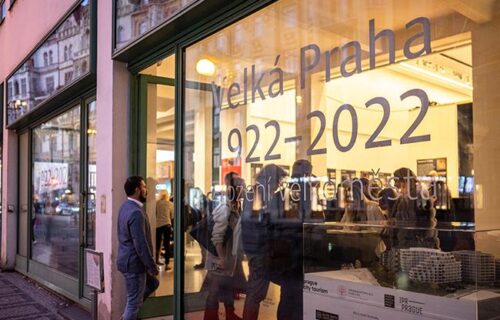This year, the Czech metropolis celebrates the centenary of the creation of the so-called Great Prague, which started the rapid and versatile development of the capital city. Currently, there is much discussion about how to combine its historical genius loci with the necessary progress and modern architecture, how to approach its sustainable growth and whether there is even a longer-term vision that would make good use of its potential. The guests of the panel debate Timelessness in sustainable construction, which took place on the occasion of the exhibition Great Prague 1922 – 2022, tried to find answers to these questions. They were Jan Řežáb (founder and owner of the JRD group), Eva Le Peutrec (renowned architect and author of 25 world skyscrapers ), Tomáš Ctibor (founder of 4ct and chairman of the Association for Architecture and Development) and Petr Vogel (energy specialist and founder of the Czech Council for Sustainable Buildings). According to the participants of this meeting, Prague could become the world’s sustainable metropolis. But it lacks a long-term concept that would count on an increase in the population up to 2.5 million, and the courage to start changing established stereotypes.
Prague has the prerequisites to become a sustainable metropolis.
All the discussants unanimously agreed that Prague does not yet have a long-term comprehensive vision of how to fulfill its potential as a large city in the heart of Europe. However, the inhabitants of the metropolis already have everything needed for its rapid and sustainable development, including resources, technologies and rich knowledge and experience. “I believe that if we think conceptually and multidisciplinary, Prague can become a truly global, sustainable metropolis. However, to kick-start modern development, we need to revise many standards and simplify complicated permitting processes so that these changes allow overall development, including sustainable compact development around important infrastructure points. Only then will Prague offer excellent living conditions for future generations. After all, the preparation and subsequent construction of a standard housing project today takes up to 7 years,” explains JRD group founder Jan Řežáb, followed by architect Eva Le Peutrec: “A functional city should have around 50 inhabitants per hectare, Prague has only 25, which is compared to many European cities such as Vienna (46), Munich (48) or Milan (75), really few. There are a number of options to make good use of the existing space: the optimal use of Prague’s brownfields, which cover around 950 hectares and on which approximately 150,000 inhabitants could live, as well as the construction of high-rise buildings. I do not consider the expansion of the suburbs to be appropriate or sustainable, because it is difficult to transport and it reduces fertile land, which threatens food self-sufficiency.”
In Prague, there are places for the construction of skyscrapers up to 130 meters high.
According to data from mobile operators, Prague already has almost 1.6 million inhabitants, which is 300,000 more than official statistics indicate. However, in order to fulfill its true potential and address future challenges in time, it is necessary to plan it as an agglomeration with more than 2.5 million people. Experts are therefore waiting for a new Metropolitan Plan, which would define the areas where high-rise buildings can be built. “There are a number of places in Prague where houses of up to 130 meters can be built without destroying its historical genius loci. Intensive, well-thought-out and conceptual development that makes good use of space will contribute to its sustainable growth and improve the quality of life of the residents. Thanks to it, the city can be more functional and environmentally friendly. However, the absence of ambitious and comprehensive planning hinders any dynamic growth and the ability to respond to rapidly changing conditions,” states urban planner Tomáš Ctibor. “And the result is that Prague has only three high-rise buildings over one hundred meters. At the same time, skyscrapers can very aesthetically complete the appearance of a city. Especially if we can combine iconic buildings in selected locations with buildings based on the wider context of the metropolis. In addition, some people do not realize that the very typology of high-rise buildings is very ecological, especially if they use modern technologies to produce their own electricity and collect rainwater (or even have a wooden structure). It is actually an entire city hidden in an apartment building with a very low carbon footprint. One household in a skyscraper produces up to 7 times less carbon dioxide than a family living in a single-family house in the suburbs,” continues Eva Le Peutrec.
Construction in Prague must better withstand climate changes.
Construction in Prague should adapt not only to the complex situation resulting from the current energy crisis, but also to climate change. The average temperature here could rise (by 2050) by up to 2 °C and the number of tropical days by 300%. “I try to be optimistic. Development is moving forward quickly, so it can be expected that technologies will soon become even more efficient, renewable resources more efficient, the energy of buildings cleaner, and individual city districts will learn to be more energy self-sufficient. But the last point is still music in the distant future. In order for Prague to be truly sustainable, it must place much greater emphasis on the construction of buildings with vegetated roofs and greenery to prevent the formation of heat islands, on more efficient management of rainwater, on a more thoughtful concept of infrastructure and on healthier and gentler methods of heating and cooling homes. And here again we encounter the missing vision of its development and outdated standards. For example, try to apply for a permit to build more than a four-story ecological building with a wooden structure. Unlike abroad, you cannot get it in the Czech Republic,” concludes energy specialist Petr Vogel.
